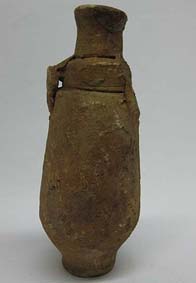As well as Leeds (if my theory is correct – see previous post), the British Museum sent objects from its excavations at Amathus to a number of other museums, public schools and colleges in 1895. According to a minute by A.S. Murray, these were:
- Ashmolean Museum, Oxford;
- Fitzwilliam Museum, Cambridge;
- Museum of Science and Art, Edinburgh; (now in the National Museum of Scotland)
- Winchester College;
- Royal Irish Academy, Dublin; (now in the National Museum of Ireland)
- Owens College, Manchester; (now in The Manchester Museum)
- Yorkshire College, Leeds;
- Nottingham Museum.
Over the last few months I’ve been trying to track down these Amathus donations, with help from the organisations’ curators, who have been very generous in taking the time and trouble to further my research. I’d love to visit more of the collections in person (in particular, Dublin and Manchester are high on my list), but I was lucky enough to have a day trip to Nottingham last month to see the Amathus collection, kindly hosted by Rebecca Arnott, Collections and Access Officer.
First I made a visit to the Nottingham Castle Museum and Art Gallery, impressively situated overlooking the city, and set in beautiful gardens – well worth climbing all the steps!
I really enjoyed the Ancient Greek gallery, which was both fun and educational and got the maximum value from the Ancient Greek objects on display. But my favourite was the ‘Every Object Tells a Story’ gallery, an inspiring ‘celebration of decorative art objects’ examining the stories behind them. This has much in common with my approach to the ancient Cypriot collections in Leeds. I loved the juxtaposition between a beautiful vase made by potter Magdelene Odundo, and three ancient Cypriot juglets and a figurine, which encourages new ways of looking at both the modern and the ancient objects, given more resonance by being displayed together.
But the main purpose of my visit was to go ‘behind the scenes’ and look at the objects from Amathus, which are not currently on display. My aim was to see if there was any correspondence between these and the objects in the Leeds University collection, which would tend to support the theory that they were originally from the same source.
There certainly were a few parallels. For example, both collections include small juglets of Black on Red ware, with neck-ridge and decorated with black bands on glossy red slip.
They also both have pilgrim flasks, of similar shapes and sizes:
This isn’t particularly surprising; both of these are very common types of objects, and probably feature in many collections of ancient Cypriot artefacts. One object I found more intriguing was this fairly crude clay bottle:
As the photos show, it’s not dissimilar to a bottle/jar in the Leeds collection, with a narrow foot, small, flat handles, and deeply incised scores at the neck. The Nottingham example is currently in several pieces; the neck (not shown) has roughly the same dimensions, and the same slight flare, as the Leeds bottle’s neck. I haven’t yet managed to identify the Leeds bottle; it’s not a typically Cypriot shape, and may well be an import. The presence of similar ceramics, slightly outside the mainstream, in the two collections may perhaps indicate that they come from the same source; or it could equally well be coincidence!
I really enjoyed my time in Nottingham and am looking forward to going back again – not least to further explore the Museum and Art Gallery, and quite possibly the café. My thanks to Rebecca for arranging my visit, and to all the other curators who have helped with this project.








